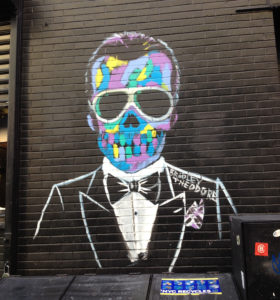In this age of Covid and lockdowns, online classes and mask mandates, one cannot help but contemplate the other great plagues that have, to put it at its mildest, ruined everyone’s plans. The Black Death ravaged Europe and Asia from 1346 to 1353, killing anywhere between 30 and 60% of the population, depending on the area. Probably one of the most humorous and begrudgingly accurate observations of our own plague pertains to the art produced during and immediately after the Black Death. Specifically, some might feel a greater connection to the subjects of many pieces of Renaissance art: chubby people with little to no clothing reclining on sofas sipping wine, not unlike many of us prancing about our homes and apartments in our underwear, sipping Malbec waiting for Zoom to load.
But one of the most interesting and morbid aspects of how the Black Death influenced Western art trends is the danse macabre. Meaning “dance of death” in French, the danse macabre refers to how death as a figure became commonplace in art. In times of sickness, it’s easy to be reminded of such a reality, hence its reflection in contemporary art. Throughout Europe in paintings, frescoes, prints, and other artistic media, skeletal figures took the living by the hand. Popes, princes, peasants, plowmen, and paupers were all made equal in death as the skeletons danced with them all. Artists made a point to show death as something universal; the common denominator for everyone.
This trend continues to show itself through artistic expression even today. The first time I saw Bradley Theodore’s work was on the Lower East Side of Manhattan. It was not in a gallery, or on the walls of a museum. It was on the corner of Ludlow and Rivington Streets, on a brick wall right next to an Italian restaurant. I had never seen anything like it before: a bust of a tuxedoed skeleton with short black hair sporting a pair of Aviators. The skull itself was made through a sort of seemingly slapdash yet precisely arranged mosaic of various shades of purple and blue, with the occasional spot of bright yellow. The mural has since been painted over, but I know that many passersby, including myself, snapped a photo.
Theodore created this mural around 2016, which is around when he made his first splash on the scene. The mural that had caught my eye was actually one of his lesser-known works, as other graffiti murals popped up across Manhattan around that time, most notably his portraits of Anna Wintour and Karl Lagerfeld. While his use of color is no doubt the greatest single identifier of his work, inspired by his upbringing in Turks & Caicos, the subject of the skeleton is almost equally as prevalent throughout Theodore’s oeuvre. Alongside Wintour and Lagerfeld, he’s also given his treatment to Beethoven, Coco Chanel, Frida Kahlo, and even Queen Elizabeth. Speaking of Her Majesty, the crowned skull is a popular subject for Theodore. Although he created many of such paintings before most of us had even heard of the coronavirus, he has continued to use this particular subject over the past two years. Theodore has stated in interviews that he uses the colorful skeletons because he sees them as “a symbol of a person’s spirit. It’s like I’m wrapping someone’s soul around their skeletal system.” While Covid clearly didn’t influence their original creation, some may be tempted to bestow these multicolored skulls with new personal meaning because of our current circumstances.
Through his own sort of danse macabre, like that of his medieval predecessors, a newer takeaway of Theodore’s work is that plague and death do not differentiate between crowned heads and bare ones, in the literal sense as well as the figurative. It’s a message that many have tried (and failed) to convey to those who have not taken things seriously. But, unlike the artisans from centuries ago, Theodore brings something new to this old tradition. By using bright, beautiful colors tessellated across brick and canvas, Theodore almost removes the morbidity from these otherwise symbols of death. What previously inspired dread is now exciting and enjoyable.
While his execution may seem innovative, consciously or not Theodore is also drawing from a long tradition of bringing light and color to death. In Theodore’s work, we’re able to see Hans Holbein and the others who painted and printed the dance of death in Europe. But alongside these long-dead European masters, there is also a still-living tradition from south of the border. Whether you’ve heard about it in Spanish class, or you’ve watched the 2017 Disney-Pixar film Coco, Mexico’s Día de los Muertos, or the Day of the Dead, is a vibrant, colorful event. It stands resplendent, ornamented with marigold flowers, paper decorations, and brilliantly-colored sugar skulls. Its conviviality is only amplified when looking at its drab American counterpart, which seems overly gloomy by comparison. The analogously lighthearted nature of Día de los Muertos has also been kept alive by artists like José Guadalupe Posada, whose skeletal etchings and lithographs not only live on as symbols of Mexican culture, but have also served as a major influence on our own modern cultural reference points like Coco. And now, the legacy of Posada and other artists, with their dapper skeletons in suits and hats, seem to live on in Theodore’s work in London’s galleries and on the brick walls of New York’s streets.
After nearly two years of living in this extraordinary time, sickness and death have seemed to surround all of us. Now with the Delta variant serving as the latest installment of our excitingly sad story, art and creativity are still needed as much as before. Bradley Theodore’s neon-colored crowned skulls are just one example of how we can find meaning in our own danse macabre.
By: Nathan Scheer

